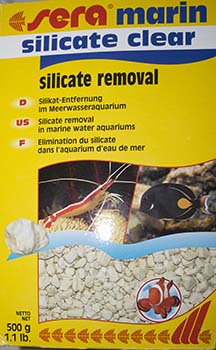Sera Marin Silicate Clear — a review
© 2018 Peter Free
28 February 2018

Not very effective
Sera's Marin Silicate Clear media did not work very well under my (possibly challenging) aquarium conditions, whether used in a canister filter or a reactor.
By challenging, I mean hard tap water with a pH of 8.2 and a TDS load of 248 to 252.
This water leaves virtually instant white evaporation spots all over everything that it touches. In the aquarium, it leaves a measurable powder rim residue in just two days of evaporation.
Three trials — canister and reactor
I tried the Clear in an Eheim canister, followed by an Innovative Marine reactor, with a subsequent re-test in the canister.
First test — Eheim Professional 4+ 250 canister
Silicate Clear comes in a plastic bag, but the box contains a black filter bag. You can rinse the media in the bag, then place the bag in a canister filter, as I did for my first trial of the product.
The Sera filter bag is wide enough to cover only half of the canister's lowest tray. Since the canister trays are all the same size, I left half of the canister's Eheim MECHpro filter media in its previous place in the other half of the tray.
After 13 days, Sera's SiO3 Test kit showed a reduction in silicates from above 2 mg/liter (from the tap) to 1 mg/liter in the tank.
That level might have been lower had I not topped the aquarium — on test day number 6 — with 3 new gallons of tap water to replace that which had evaporated.
This reduction from 2+ to 1 ppm made no difference in the comparatively long brown diatom outbreak that I was trying to fix.
Sera's website claim that silicate reduction to 1 ppm (or less) is worthwhile may, therefore, be questionable under some conditions. My cycled aquarium water has consistently had 0 ammonia, 0 nitrites, and fewer than 5 ppm nitrates.
Keep in mind, however, that there are so many variables in these situations that proving any hypothesis is likely to be too challenging for a hobbyist.
One of the obvious among these 'don't know for sure' conundrums is the fact that silicate content declines in a sloping function. Consequently, Sera could reasonably argue that my tank was not long enough in the 1 mg/liter state to make a biological difference in the diatom bloom.
I won't argue with that. However (as we will see), the counterpoint might be that the Sera product works so slowly and is so easily depleted that the 'time in end state' problem is financially irrelevant.
Second test — Innovative Marine MiniMax (medium size) reactor
I wanted to see whether gently tumbling the Silicate Clear would speed up its ability to adsorb silicates.
So, I put about one-third of the product into an Innovative Marine medium sized MiniMax installed in one of the of Innovative Marine's all-in-one tank's water return wells.
This test worked out poorly.
First, the MiniMax is temperamental and requires constant flow adjustments.
Second, its channel-like (meaning only partial) tumbling appears to have split tiny pieces of the Silicate Clear medium off its larger granules and circulated these micro dabs into the aquarium.
I noticed a white frizz begin to show up on the edges of my moss balls and plant leaves. White deposits, unlike the hard water's evaporative ones, began to show up on the sides of the tank, some of them intermingling with the diatom splotches.
This whitish mess, and the boldly renewed brown diatom outbreak that occurred simultaneously, had become so pronounced that I removed the MiniMax on day 12 of the test. That's a day earlier than I had removed the Silicate Clear from the Eheim canister.
On day 12 of the reactor test, Sera's SiO3 test indicated a silicate load of closer to 2 mg/liter than 1 mg.
As with the canister trial, I had replaced evaporated water only.
In short, the canister had done a better job with the Silicate Clear and without making a white mess in the aquarium.
Third test — back into the Eheim canister
At this point, I was not sure whether the Clear's ability to reduce silicates had been depleted.
To find out, I stuck it back into the canister. This time, putting the total (meaning that from the MiniMax, as well as the saved leftover from the previous canister test) into two (non-Sera) filter bags.
I spread these two bags side by side into the lowest canister tray. Coverage of the tray was complete, unlike the thicker-but-half-tray coverage that I had had before.
Complicating this last test was the fact that cleaning up the white mess (generated by the MiniMax) and removing the diatom bloom (again) required changing about 80 percent of the water in the aquarium. Roughly 27 gallons.
The replacement water obviously contained a fresh supply of tap water silicates.
Sixteen days later, Sera's SiO3 Test still showed 2 mg/liter.
Obviously, the Clear had not been doing anything substantial during this last round of testing. The Sera media were probably depleted.
My tentative conclusions
Silicate Clear appears to be neither:
(a) efficient — meaning with regard to quickly adsorbing silicates
nor
(b) volumetrically worthwhile — meaning it costs too much for the very little water it successfully treats.
The moral? — A waste of time, effort and money
For my conditions, the Sera Silicate Clear was useless. Even according to Sera's own SiO3 Test.
The Sera silicate-adsorbing media might work adequately for a nano tank (meaning 10 gallons or less) that contains tap water silicate levels already well below 2 mg/liter.
For anything larger or higher, I would pass.
This is not a surprising finding. In looking at reviews of competing American-originated products, I noticed an overall lack of enthusiasm.
The obvious fix, but with its own form of included waste, is an RODI — meaning Reverse Osmosis and Deionization — system.
 PeteFree.com
PeteFree.com